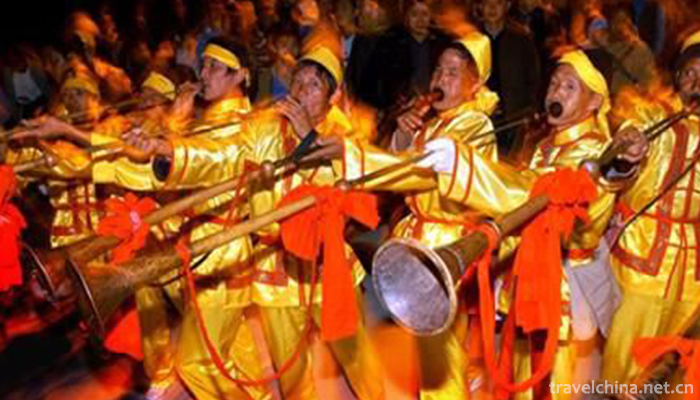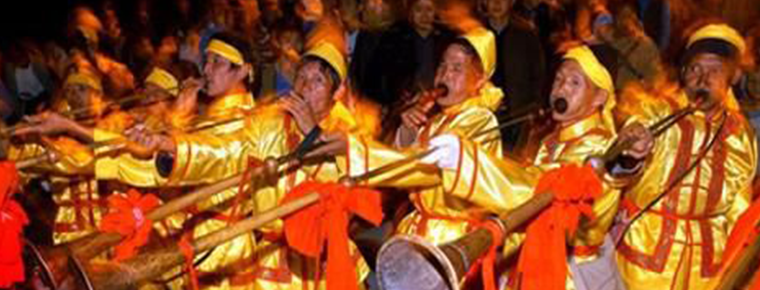Gelao Maolong Festival
Gelao Maolong Festival
"Gelao Maolong" is a form of folk worship handed down from generation to generation by Shiqiao Gelao people. It mainly spreads in the Ming and Longfeng villages of Longjing and Tangshan towns in Shiqian County, Guizhou Province. It radiates to Dong, Miao and Tujia nationalities all over the county. Maolong of Gelao was mainly active during the Lantern Festival. Some scholars concluded that Maolong originated from the worship of bamboo king and reproductive worship of Gelao in ancient times.
On May 20, 2006, the "Gelao Maolong Festival" declared by Shiqian County, Guizhou Province, was listed in the first batch of national intangible cultural heritage list with the approval of the State Council.
Festival History
Origin of Festivals
Historically, the Gelao people living in the southwest of China did not receive the attention of the ruling class and feudal scholars. There is no clear historical record of the origin and origin of the "Gelao Maolong". Some scholars speculate that Maolong originated from the worship of bamboo king and reproductive worship of ancient Gelao.
The Gelao people in Yanming area of Longjing Township have a story of "the son of the dragon who chopped the golden bones in Tang Wei Zhengmeng". It is said that "Gelao Maolong" is the eldest son of "Golden Bone Laolong". It basically coincides with the story of "Wei Zhengmeng chong" in the Chapter Hui novel "Shuo Tang". In addition, according to Shiyan County Record, "Lantern from Tang Dynasty", the local "Maolong" belongs to "lamp". One kind, so it can be inferred that "Gelao Maolong" can follow to the flourishing Tang Dynasty. From the main situation of "Gelao Maolong" activities in the territory recorded in Shiqian County Records of the Republic of China, from the end of the Qing Dynasty to the eve of liberation, "Gelao Maolong" prevailed in villages of all nationalities in the county.
Relevant literature
"Gelao Maolong" is mainly active during the Lantern Festival. There is no clear historical record about the origin and origin of Gelao Maolong. Some scholars have deduced that Maolong originated from the ancient Gelao's worship of "bamboo king" and reproductive worship. According to Shiqian County Chronicle, the story of "the dragon lamp from Tang Dynasty" and "the son of the Elder Dragon in Jingu County in Zhengmeng County in Tang and Wei Dynasties" has also been circulated among Gelao people. Therefore, it can be inferred that "Gelao Maolong" can be traced to the flourishing Tang Dynasty. According to Shiqian County Records of the Republic of China, from the end of the Qing Dynasty to the eve of liberation, "Gelao Maolong" prevailed in villages of all nationalities in the county.
Major activities
Movable appliances
1. Instruments
Gelao Maolong Festival is mainly used for percussion instruments. Various sets of douqu cards play an important role and significance in the corresponding links. The main musical instruments are: horse gongs, copper body sonators, disc-shaped, about 16 cm in diameter, different sizes, sharp tone, crisp. Cymbals (usually two pairs), copper sonators, disc-shaped, diameter between 35-40 cm, sound is relatively low, thick. Drum, barrel-shaped, covered with sheepskin or cowhide at both ends, is a membrane song instrument with a diameter of about 30 cm and a height of about 18 cm. It is a soul instrument and plays a commanding role.
2. Strengthened bamboo, bamboo strips, mangosteen, leather paper, pigments, strip knives, paper cutters, etc.
3. The "ringing bells" of male and female dragons following Maolong are copper products.
4. Baochai, which supports Longbao, is an iron product. It has special requirements when it is made and related ceremonies are to be held.
5. Folk "Mao Long" oral belief system: including folk ritual secrets, copies of "Long Sentences" and oral materials about traditional stories, lyrics and acrobatics among folk artists.
6. Relevant ceremonial and performance venues of Maolong.
Activity content
Shiqian's Gelao Maolong Festival is a folk belief activity based on the folk "dragon god" belief of Gelao people, which lasts from the 30th of the New Year to the 15th and 16th of the first lunar month. Dragon worship is the core of Gelao Maolong. Its basic elements include: 1) the belief in dragon, including traditional stories, rituals, occasions and supplies for worshipping dragons and recitations for worshipping dragons; 2) affiliated totem beliefs, including "bamboo king" worship, Panhu worship, folk Buddhism and Taoism worship and primitive worship; 3) tie-up techniques, including material selection (bamboo bars, colored paper) and crafts; 4) playing skills, bags, etc. Including "two dragons rob treasures", "lazy dragon turn over", "single dragon play beads", "swan hold eggs", "inverted golden hook", "rhinoceros look at the moon" and "screw top". 5. Recitation, including "open light", "invite water", "burn dragon" ritual recitation and "open the door of wealth" and "worship the God of wealth" and other performances.
According to legend, in ancient times, the inheritance of Gelao Maolong was mainly spontaneous inheritance and natural inheritance. The so-called spontaneous inheritance means that young people take the initiative to learn Gelao Maolong's tie skills, playing skills, "Dragon Sentences" and Maolong's legends, musical instruments accompaniment, etc. The so-called natural inheritance refers to the inheritance of Gelao Maolong without any rituals of worship and disciplining, but as a natural inheritance of the national belief, its way of inheritance is oral and heart-to-heart teaching. According to the collected data, since the Qing Dynasty, the "Dragon Sentences" of Gelao Maolong activities, such as "Opening the Gate of Wealth" and "Jingxiang" gradually appeared in the handing down of written records in Chinese. Now, three copies are collected as an auxiliary form of oral and heart-to-heart transmission.
Inheritance value
Although the inheritance of the ancient Gelao Maolong Festival is mainly spontaneous and natural, it is more casual, but from the perspective of ceremonial presiding, tie-up and the role identity of the leading and tail performers, it still shows the stipulation of inheritance.
"Gelao Maolong" has rich cultural value, showing its unique national, regional and diverse social functions. It is the study of ancient Gelao culture.
The precious wealth of tradition. "Gelao Maolong" is a manifestation of folk beliefs handed down from generation to generation by the Shiqian Gelao people. It mainly spreads among the Dong, Miao and Tujia nationalities in the towns of Longjing and Tangshan in Shiqian County, Guizhou Province. Shiqian, located in the northeast of Guizhou Province, belongs to Tongren District, is a small mountain county in the hinterland of northeast Guizhou Province. The terrain is complex, the landform is diverse, there are many underground hot springs, and the natural ecology is well preserved. It also has the reputation of "Hot Spring Town". Shiqian has a long history of civilization. As early as the Qin Dynasty, Yelang County was located in the county territory. There are 13 nationalities in the territory, including Han, Gelao, Dong, Miao and Tujia. Gelao is the most populous minority in the territory. People of all nationalities have lived in harmony for generations, showing a unique open mind. "Gelao Maolong" is rooted in such a cultural ecological environment.
Current situation of inheritance
After the reform and opening up, because of the drive of economic interests, few young people are keen on the cause of "Maolong". The impact of modern civilization also makes people's aesthetic interest evolve. The appreciation group of "Gelao Maolong" is gradually limited to the elderly. The activities of "Gelao Maolong" mainly rely on the government to organize.
The Gelao Maolong Festival has rich cultural value and shows its unique national, regional and diverse social functions. It is a valuable treasure for studying the cultural traditions of the ancient Gelao people.
The State attaches great importance to the protection of intangible cultural heritage. On May 20, 2006, the folklore was approved by the State Council and listed in the first batch of national intangible cultural heritage lists.


-
1.stired egg and tomato
Scrambled eggs with tomatoes, also known as tomato scrambled eggs, is a common popular dish among many people's families. The cooking method is simple and easy to learn, and the nutrition is reasonabl
Time 2018-10-27 -
2.PRC Cradle Scenic
Cradle Scenic Area of Ruijin Republic, National AAAAA Tourist Scenic Area, National Key Cultural Relics Protection Unit, National Patriotic Education Demonstration Base, National Red Tourism Classic S
Time 2018-12-08 -
3.Yuan Dynasty Capital City Wall Site Park Yuandadou Chengyuan Site Park
The Yuandu Chengyuan Site Park was built on the Tucheng Site of Yuandu (National Key Cultural Relics Protection Unit, batch No. VI-1). It is located near Mingguang Village, Southern College Road
Time 2018-12-23 -
4.Kunyu Mountain National Forest Park
Kunyushan National Forest Park is located in Mouping District, Yantai City, Shandong Province. It covers an area of 48 square kilometers and belongs to warm temperate monsoon
Time 2019-01-29 -
5.Venus Inkstone Making Skills
Venus inkstone making technology, the local traditional handmade inkstone making technology in Xingzi County, Jiangxi Province, is one of the national intangible cultural heritage.
Time 2019-05-07 -
6.Auspicious gongs and drums in southern Shanxi
Weifeng gongs and drums in southern Shanxi are folk traditional percussion music which was born and popular in Linfen area of Shanxi Province. The first batch of them were selected into
Time 2019-05-07 -
7.Linxia brick carving
Linxia brick carving (also known as Hezhou brick carving) is a practical art closely combined with buildings. Linxia brick carving matured in the Ming and Qing dynasties, and in modern times it absorb
Time 2019-05-13 -
8.Sibo Belem Dance
"Bailun" dance is the generic name of Xibo self-entertainment dance and the first type of Xibo folk dance. It originated from an ancient dance that imitated life and production posture in th
Time 2019-07-01 -
9.Maogus Dance of Tujia Nationality in Western Hunan
Maogus Dance of Tujia Nationality in Western Hunan Province, the traditional dance of Tujia and Miao Autonomous Prefecture in Western Hunan Province, is one of the national intangible cultural heritag
Time 2019-07-06 -
10.Song pool of the Zhuang nationality
Song pool of the Zhuang nationality is a form of Festival gathering and singing activities held by the masses of the Zhuang nationality at a specific time and place.
Time 2019-08-16 -
11.Zeng Bu
Zeng bu (November 3, 1036 - August 21, 1107), Zi Zi Xuan, Tai Chang, son of Yi Zeng, brother Zeng Gong of Zhong Shu Shu, the Prime Minister of the Northern Song Dynasty, and the important supporter of
Time 2019-09-15 -
12.University of Chinese Academy of Sciences
University of Chinese Academy of Sciences ( University of Chinese Academy of Sciences Referred to as "National Science and Technology University", was approved by the Ministry of education.
Time 2019-12-11